Namibia part 7: an abundance of zebras
- guymavor
- Aug 26
- 12 min read

In planning this trip without fully grasping the vastness of the landscape, I found various 4x4 tracks on the comprehensive but sometimes optimistic Tracks4Africa map online. These led in a relatively straight line 100km eastwards from Etendeka to Hobatere, our next stop. Google (to its credit) would not allow me this option, offering a long loop south on actual roads, so I emailed Etendeka in April. That road has been washed away came the response, from Kapoi as it turned out. Looking at the landscape, it is unlikely that it was much of a track in the first place (moral of the story: unless you are a fully-autonomous, multi-vehicle expedition, remember Big Mattias’s lost tourist horror stories - I'll spare you the details - and don’t travel off-road!).

We go the long way round in the company of Reuben, Etendeka’s electrician, who is beginning his two-week leave and is off to Windhoek to see his girlfriend. Six weeks on, two weeks off is the rhythm in this industry, which as a teacher in a boarding school is relatable, although many lodges close for longer periods, either in fierce heat or rain, or for maintenance. Etendeka doesn’t seem to, but in summer the hiking trails will be hot.
As a language teacher, I am also in awe of multilingual Namibia. Everywhere we have stayed, people speak at least four. Seven is not unusual. As we drive, Reuben, who used to work down south in mining, explains the lingua franca of the industry, which has a solid base of Afrikaans and words from other languages mixed in. We talk about conservation and conservancies in the area, and he talks about his heritage – Herero and Himba – and different dialects and words. The time passes quickly, for me at least. Reuben advised against stopping as we did to give water to road crew maintenance teams, who apparently aren’t always what they seem, and I’d usually be cautious about picking up hitch-hikers, but this lift was arranged at the lodge. If you ever have the chance to do something similar it will add a layer to your trip. Hospitality on our trip was warm and genuine, but it is always worth trying to get beyond the host-customer dynamic. At Kamanjab we drop Reuben and stock up on a few provisions for Etosha, our second self-catering stop (don’t buy meat, as you cannot take it into the park – rest camp shops have a good selection in freezers) in a couple of nights' time.
We drive on to Hobatere lodge, a former private 9,000 hectare concession on the edge of Etosha, now owned and warmly-run by the local community. The chef is excellent, the dancing joyful. It is ‘rustic’, apparently, which I think means not ultra-designed. The high ceiling and thatched roof of its large central area remind me of older Kenyan or South African lodges, but it was rebuilt only 10 years ago and has 15 rooms rather than 60, so it is peaceful. You can just relax and watch the waterhole or go on game drives with excellent guides, including night drives. It is also a good base from which to explore the west of the park. It is beautiful bush, far more so than Etosha, with a rich variety of species but not the big numbers of the national park. We see small groups of giraffe, oryx, springbok and mountain zebra. There is a picturesque sand river reminiscent of the South African lowveld at time, especially the lingering greenness of it. There are signs of recent flooding everywhere. Like everywhere else in the country, it received unusually good, late rain this year. There is a lot of birdlife here for Namibia in midwinter. We see a tawny eagle devouring a guinea fowl and Verreaux’s eagle owls catching starlings. On our night drive we see bat-eared foxes, a genet, a chameleon and a hint of a leopard on a distant rock – barely a sighting but I’m counting it.
The highlight is male lions announcing themselves with a prolonged bout of roaring as they pass the camp at midnight. Lions’ movements are closely monitored here, with livestock on adjacent land, and the next morning we track a pride to a hillside overlooking a waterhole in the west of the concession. They gaze out at us in the same way they would with anything else which moves – is it edible? It is an unsettling treat to finally meet the top of the food chain.
What is the collective noun for zebras? In Etosha at least, it’s an ‘abundance'.
In Etosha the next day, after entry via the decisively-not-in-the-hospitality-business Galton Gate (the vibe of our interrogation and car search for meat and plastic bags, is more don’t mess up our park than welcome to Etosha, which is fine) we have the same thrill, but closer. A pride of 6 lions is sleeping in the shade of a tree on the main gravel road. With one other vehicle there already, we sit and watch them. They have eaten well recently, with legs pointing upwards, away from distended bellies. A young male gets up to walk past our car, locking eyes at 3 feet with Lily, who has taken her sunglasses off. There is a car window between them, but “Dad, can we go?” is the understandable response. We stay a moment longer and move on.

Etosha is extraordinary. By this point we have stopped at 5 or 6 waterholes, with Lily writing down the species we see at the first 3 before realising that it will be the same story everywhere we stop: abundance. But not the crowds of other big African national parks, which I had expected. Only once does someone drive in front of us a little too forcefully at a predator sighting, and there are only 5 vehicles anyway. We are in peak season but compared to Kenya or the Kruger there is no crowding anywhere we stop.
And the animals are less stressed than I expected too. There is far more grass than on my last two trips in May and June of the years I visited, when all I remember is clouds of dust as long queues of hot, biting, bickering zebras looked for grazing and waited for water. The grass is dry now but still high, indicative of abundant and impactful rains. There are so many baby animals and pregnant zebras just mooching around, fat and happy.
Sights of western Etosha, including Dolomite Camp, in a lovely setting on a ridge
There are three contenders for the Ultimate Waterhole Spectacle in Etosha, and many more where you will just see elephants playing, or giraffes stooping to drink like a collapsing ladder, or crowds of springbok butting heads, or long lines of zebras, oryx, kudu and wildebeest. The first of these is, in theory, Olifantsrus, a not-very-pretty, basic campsite in the western section of the park with a long, raised walkway out over the fence leading to a large, round two-floor building. From the top floor, there are views out over the plain, but from the ground floor you look out through plexiglass – and up! – at elephants coming to drink from a wide trough set all around the building. It is essentially an elephant hide, although every other kind of animal, including predators, also comes to drink here. There were no elephants when we visited but apparently they are reliably there at various times of the day (ask at Hobatere). I can only imagine it is a thrill. You cannot (and definitely should not, anywhere else) get much closer to these giant creatures.
Olifantsrus elephant waterhole hide. You have to get out of the car and open the gate yourself.
The second contender is the world-renowned floodlit Okaukuejo waterhole which for many people is the main reason to come to Etosha. Okaukuejo is the park’s administrative centre, with sprawling offices and staff accommodation beside the camp. There are also road upgrades and diversions outside the camp when we visit, a mess of dust and diggers. However, none of this is apparent at the waterhole, which sits in a hollow 30 metres beyond the semicircular arc of a low wall set above the electric fence at the quiet end of camp. You can stay in a premium waterhole bungalow, although only a couple are two-storey and have the view, but it really doesn’t matter where you sleep – there is accommodation for every budget, including a campsite, and space for everyone at the waterhole, with benches arranged at regular intervals around it, and even a small grandstand. It is standing-room only when we arrive in the late afternoon, but the crowd of 200 or so is hushed and respectful, watching the ever-changing show. Right now, it is a family of elephants, drinking and hosing themselves down. They have the place to themselves apart from a gaggle of guinea fowl the other side. In the far distance beyond the thicket, Sian and Lily observe through binoculars a stand-off between an immobile, aggressively-staring stand of a dozen giraffes and a pair of lions. Neither come to the waterhole this time. We are told later there is a giraffe carcass from a lion ambush two days earlier near the thicket, which explains the hostility (I'm not making up the aggression: giraffes are curious, languid normally, and look like they are smiling benignly - here, they had a rigid body posture and a fixed stare. The lions retreated first. A well-aimed giraffe kick would kill them).
Late afternoon at Okaukuejo
As dusk falls, the show just gets better, especially since the animals emerge suddenly from the darkness beyond the range of the floodlights, as if onto a stage. We watch a pair of male lions lapping away. Then the stars of the night, black rhinos, arrive. They come alone or with a calf, but also socialise briefly with each other, the male approaching the female, who snort (a warning?) or look amenable (I don’t know, rhino body language is not that obvious…) while the calf waits alongside her. We see five, even more at Halali.
Night time visitors to Okaukuejo
The next morning we are up early at the waterhole. As with every national park rest camp here and in neighbouring South Africa, there is a ban on night driving, so diesel engines starting up add to the dove-led dawn chorus. We sit out the rush to get out of camp. There are kettles in the rooms. A cup of tea and a seat in the grandstand are an appealing prospect, with long lines of sight across the plain for spotting the queue of animals waiting for their turn to drink. They come mostly in species groups but sometimes jumbled up. There is a large acacia tree off to the left, where herons then a tawny eagle perch as we watch, and a thicket opposite where predators may or may not be lurking. Various animals are spooked and turn back – wildebeest especially – when the wind rustles it, but there are also lappet-faced vultures on the branches of a dead tree next to the thicket, which I imagine doesn’t help the nerves. Oryx, we find, approach slowly and decisively, often into the water, kudu likewise but more quickly, wildebeest with many false starts, warthogs with not a care in the world but also with the vibe of a creature always ready to flee. Springboks display all of the above traits but of the older, solitary males are downright nonchalant. Around us, red-breasted shrike make a racket, martins and other birds fly overhead, some swooping to skim a drink from the surface. The guinea fowl are back. Their collective noun is a ‘confusion’, which is about right. The waterhole gradually gets less busy so we decide to pack up for a day drive to our next stop, Halali.
Driving around Etosha is magical. In the east of the park there are more vehicles than in the west, with bigger trucks from lodges outside the park, but it isn’t exactly ‘traffic’. We see gatherings of game by hundreds, springbok and zebra especially, but also large groups of wildebeest, oryx and black-faced impala, and a few unusual sights, such as giraffes by the road chewing a bone, for the calcium and phosphorus. There are pairs of hornbills everywhere, and more purple-breasted rollers as we move east. We see bateleur eagles in the distance, circling high. At ground level, we sometimes spot lappet-faced vultures finishing off the last scraps of a carcass. Ostriches and kori bustards patrol the grass, as do korhaans, always in pairs close to the road. We wind our windows down for them: the Rüppell’s croak to each other across the plain like frogs, while the black korhaans seem to stand closer and cackle at each other’s jokes. Spurfowl (francolin) and guinea fowl run from our approaching car, but sandgrouse stay still, beautifully camouflaged in the dry grass. This is not ideal if they freeze on the dusty road, but we manage to avoid them.
Having stopped to observe a double-banded courser, we realise we don’t have time to go full birder and drive on, turning towards the pan. A lone acacia in the distance has three vehicles beneath it. Perhaps they are just there for the shade, but it’s always worth a look, and the grassland and shallows gullies at the edge of the pan in the afternoon sun are beautiful and atmospheric in themselves.
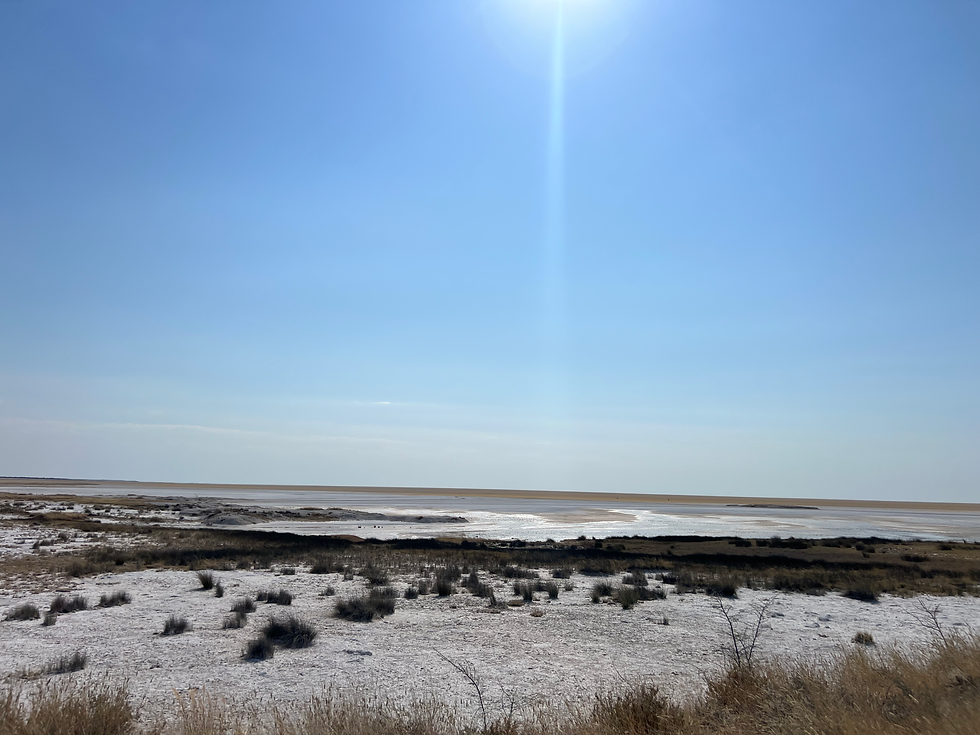
As it turns out, it’s two fat male lions, cuddling each other after a heavy meal. But even as we park up within 5 metres, we don’t realise this and just stare out hopefully from the car (the grass is tall this year, I might have mentioned…). But then a very big head pops up, two round ears sticking out from a mane, before flopping down again. We sit and watch, with a brief interlude while the exception-to-the-park-vibe idiot I mentioned earlier drives in front of us to get his shot for 2 minutes.
We eventually spot them
At the next waterhole, three bull elephants are drinking from a high-sided elephant trough as we arrive. When he has finished, the first has a bout of mischief, suddenly galumphing down the slope directly towards the gap where we have parked, his head shaking from side to side. He stops just as quickly after a few paces, and I swear he’s grinning. But it has had the desired effect: I have started the engine and we are on the move again.
Halali, with deserted waterhole during the day. At night, it's a different story.
Our last stop, Halali, is a quiet, dusty, functional camp, spread out under the mopane trees typical of this area. These are bigger than those outside the fence, having been protected from elephants for decades by it. The restaurant, like Okaukuejo’s, is OK, judging by the breakfast (we cook dinner on our own fire), but empty, unlike the bunfight at the former. Staff here have the time to be friendly and unstressed. At HQ they were nice but in a rush. There is a big pool and a bar area which will be welcome in the summer. We stay in a two-room family rondavel with an outdoor table and chairs and a braai. It all works, but nothing here has ever won a design prize, except perhaps the waterhole seating area which benefits from being on a rocky outcrop overlooking the water.
It feels like a theatre again, with 70-80 people seated and standing quietly on the rocks. The show is extraordinary, after dark at least, a rhino play in several acts. Three (or maybe two, one pair twice) different mothers and calves enter and exit stage left, with several bulls coming and going from all directions too. There are long interactions – stares, really – including one which looks tender and meaningful, although perhaps it is just rhino myopia, as well as the occasional whistle.
There is a snorting face-off between two bulls with a bit of pushing, playful I think, and laughing noises-off from a lone hyena (playing Falstaff), who emerges from the dense bush surrounding the waterhole several times to drink, only to be chased off again by a rhino. The quiet murmurs and gasps from the human audience add to the spectacle, which has elements of farce, improvisation and, perhaps, unrequited love. Joking aside, it was genuinely moving to see so many (7 or 9) of these critically endangered animals living their best life, which is why I award it, for this trip at least, my Etosha Top Waterhole prize.

From Halali, we drive around the edge of the pan, even into it at a 'lookout' point. The pan is completely flat, all white. It is vast, obviously, but to my mind the pan looks more impressive with something in the foreground (grass, a tree, anything!), or on the southwest or southeast corners where you can see the shimmering silhouettes of animals taking a shortcut across the angle. We spotted lines of elephants and groups of ostriches at various points. The lookout point was just a truckload of tourists (and us) taking photos.

The eastern side of the pan dries out last after rains so there is more birdlife, but we do not have enough time to explore it (that two days is not enough! refrain again).

On our way out of the park, we stop briefly at Namutoni, another quiet camp, essentially an average hotel in a picturesque old German fort with a campsite next to it, it also has a floodlit waterhole, less impressive (from memory – 23 years ago, don’t quote me!) than the ones in the other two main camps. The last few miles are on tar but still with plenty of wildlife. We stop to watch giraffes, not even remotely sated. Etosha, you have been wonderful. We’ll be back. Now for somewhere a little bit different.


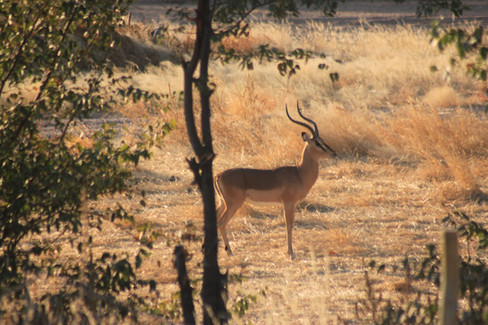











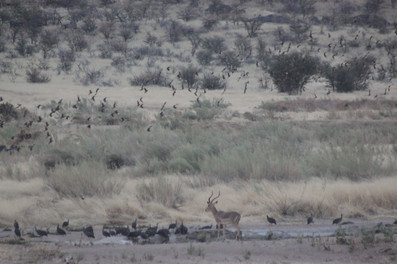





















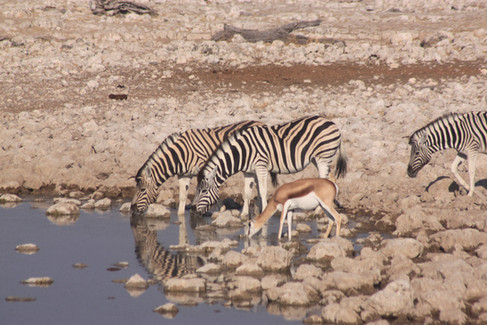









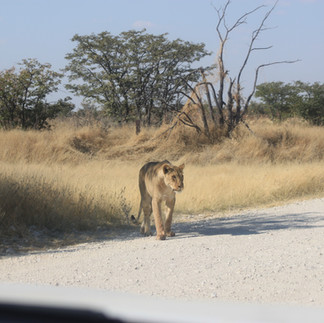





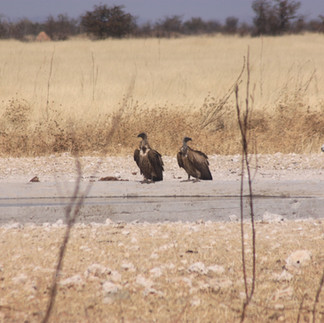






































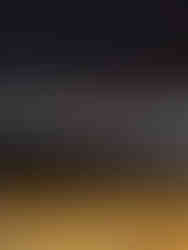





































































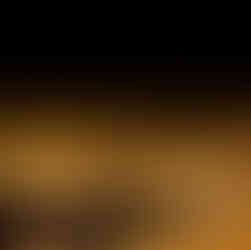





Comments